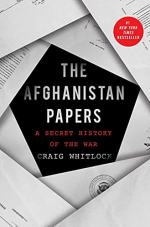|
This section contains 908 words (approx. 3 pages at 400 words per page) |

|
The Afghanistan Papers Summary & Study Guide Description
The Afghanistan Papers Summary & Study Guide includes comprehensive information and analysis to help you understand the book. This study guide contains the following sections:
This detailed literature summary also contains Topics for Discussion on The Afghanistan Papers by Craig Whitlock.
The following version of this book was used to create the guide: Whitlock, Craig. The Afghanistan Papers: A Secret History of the War. Simon & Schuster, 2021.
Craig Whitlock’s book is divided into six parts and twenty-one chapters. The author chronologically divides the war into six discrete stages that mirror the chronology of the book.
Chapter One: A Muddled Mission sets the scene of the early days of the US invasion of Afghanistan and focuses on the Bush administration’s attitudes to the war in its early days.
Chapter Two: “Who Are the Bad Guys?” presents the conundrum of setting war aims and restricting combat to a specific set of militants in Afghanistan. Chapter Three: The Nation-Building Project explores how the mission shifted militarily and politically. It explores the difficulties in construing a vassal state and maintaining an occupation in a distant land from an incongruent culture.
Chapter Four: Afghanistan Becomes an Afterthought explores how the war in Iraq shifts the Pentagon’s priority away from Afghanistan. Whitlock asserts that the Iraq War made the Afghanistan War less winnable.
Chapter Five: Raising an Army from the Ashes, examines the training of the Afghan Army as a proxy fighting force.
Chapter Six: Islam for Dummies looks at the inadequate cultural training that US occupation soldiers received before deploying it Afghanistan. Whitlock details the work of Army Psychological Operations teams in pacifying the Afghan populum.
Chapter Seven: Playing Both Sides contextualizes Pakistan’s strategic position in the war. Pakistan’s role in aiding the Taliban insurgency is scrutinized from a geostrategic perspective.
Chapter Eight: Lies and Spin explores the Pentagon’s public relations efforts as the war becomes more protracted.
Chapter Nine: An Incoherent Strategy details the transition from Donald Rumsfeld to former CIA Director Robert Gates in the Secretary of Defense. Whitlock presents a discernible strategy shift but does not explain much of the nuts and bolts of this beyond depicting two divergent personalities.
Chapter Ten: The Warlords describes glaring discrepancies between US avowals of pursuing human rights in Afghanistan and the records of its closest military allies there. It paints a picture of unchecked savagery in country and meekly probes US complicity as an occupying power operating in the country through a series of political and military proxies.
Chapter Eleven: A War on Opium explains the opium trade in Afghanistan which flourished under the US occupation. The chapter portrays life in Afghanistan’s southern Helmand province, where most of the country’s opium is harvested. At its peak, 80% of the world’s heroin was coming from Afghanistan. Whitlock assess the army’s Operation River Dance, overseen by the US Drug Enforcement Agency.
Chapter Twelve: Doubling Down discussed the transition from George W. Bush’s presidency to that of Barack Obama. It explains Obama’s initial plans for the war in Afghanistan and presents a demarcation in strategy and political style.
Chapter Thirteen: “A Dark Pit of Endless Money” explains the nation-building project in Afghanistan in administrative terms. It depicts the US agencies that oversaw the reconstruction efforts in the country. Whitlock nods towards the spectacular corruption in military disbursements and the enrichment of American contractors working in Afghanistan.
Chapter Fourteen: From Friend to Foe profiles the presidency of Hamid Karzai and explains the political maneuverings of this fairly supine figure reliant on the US occupation to stay in power. Karzai’s political situation becomes increasingly untenable as the US military commits a series of gruesome atrocities in Afghanistan. This forces Karzai to take a more confrontational posture with his imperial overlords.
Chapter Fifteen: Consumed by Corruption describes the collapse of the Afghan financial system, which is marked by many layers of corruption. The figure of Sherkhan Farnood plays a key part in this story.
Chapter Sixteen: At War with the Truth describes the deterioration of the US war effort in Afghanistan. Despite being politically buoyed by the assassination of Osama bin Laden, President Obama finds his plans for the war soured by facts on the ground.
Chapter Seventeen: The Enemy Within elaborates on cases of fragging by Afghan army members, attributed to Taliban infiltration of the Afghan Army and national police force.
Chapter Eighteen: The Grand Illusion explores the Obama administration’s declaration of the end to the combat mission in Afghanistan. Despite this legalistic shift, the United States retains 10,800 US occupation troops in the country, notionally serving on a peacekeeping and advisory mission. This, according to the president, but contradicting observable reality, brings the US war in Afghanistan to a “’responsible conclusion’” (207).
Chapter Nineteen: Trump’s Turn tries to grapple with the ways in which the Trump administration approached the war. Whitlock parodies Trump’s demeanor and presents a highly contradictory account of the machinations that took place within the president’s cabinet.
Chapter Twenty: The Narco-State returns to discussion of the opium trade in Afghanistan. Whitlock looks at the army’s Operation Iron Tempest, which sought to eradicate poppy cultivation without success.
Chapter Twenty-One: Talking with the Taliban narrates the negotiations which led to the withdrawal of US troops from Afghanistan. These negotiations, hosted by the kingdom of Qatar, ultimately lead to a concession of US defeat and a commitment by President Trump to fully withdraw al US troops from Afghanistan by May of 2021. Trump’s successor, President Biden does not renege on this commitment and the war mercifully ends in in ultimate humiliation for the United States in 2021 after two decades of senseless slaughter.
Read more from the Study Guide
|
This section contains 908 words (approx. 3 pages at 400 words per page) |

|



